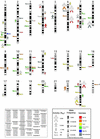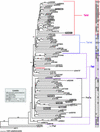Hot L1s account for the bulk of retrotransposition in the human population - PubMed (original) (raw)
Hot L1s account for the bulk of retrotransposition in the human population
Brook Brouha et al. Proc Natl Acad Sci U S A. 2003.
Abstract
Although LINE-1 (long interspersed nucleotide element-1, L1) retrotransposons comprise 17% of the human genome, an exhaustive search of the December 2001 "freeze" of the haploid human genome working draft sequence (95% complete) yielded only 90 L1s with intact ORFs. We demonstrate that 38 of 86 (44%) L1s are polymorphic as to their presence in human populations. We cloned 82 (91%) of the 90 L1s and found that 40 of the 82 (49%) are active in a cultured cell retrotransposition assay. From these data, we predict that there are 80-100 retrotransposition-competent L1s in an average human being. Remarkably, 84% of assayed retrotransposition capability was present in six highly active L1s (hot L1s). By comparison, four of five full-length L1s involved in recent human insertions had retrotransposition activity comparable to the six hot L1s in the human genome working draft sequence. Thus, our data indicate that most L1 retrotransposition in the human population stems from hot L1s, with the remaining elements playing a lesser role in genome plasticity.
Figures
Figure 1
Chromosomal location, activity, allele frequency, and subclass of 82 full-length L1 elements with two intact ORFs.
Figure 2
L1 activity distribution. The measured potential activity of L1s from both the HGWD and de novo human insertions is shown. The histogram depicts the activities of 82 intact L1s from the HGWD and five human L1s involved in recent disease-causing insertions. The entire pie in the pie chart represents the total of all of the activity of the 82 L1s from the HGWD. Each slice of the pie represents the activity of a single element. The six hot elements (blue slices) represent 84% of the total measured potential activity in the HGWD.
Figure 3
Neighbor-joining tree with 89 intact L1 elements. The tree was constructed by using the full L1 sequences as described in Materials and Methods. The nodes recovered >60% of the time in 1,000 bootstrap replicates of the data are indicated, excluding CpG dinucleotides and the polypurine tract in the 3′ UTR. Ac009269 with the ≈400-bp deletion in the 5′ UTR was not included. Polymorphism and activity data are appended in the column on the right. A question mark signifies that the experiment was not performed. Hot elements are followed by asterisks, and noncanonical elements are boxed. The consensus sequence of the 89 elements is indicated. The Ta-0 subgroup that clusters between the ancestral L1Pa2 elements and the pre-Ta group had been identified (31). Based on short branch lengths, polymorphism data, and the in vivo activity of one member (LRE2/al389921) (21), the subgroup was predicted to be relatively young (31). We verify that prediction by showing four of five tested members to be polymorphic and all tested members to be active. This group is canonically Ta-0 based on seven defining nucleotides (Table 1). However, the group appears similar to L1Pa2 ancestral L1s based on its position in the tree. Preliminary sequence analysis comparing these L1s to the two L1Pa2 elements shows ancestral nucleotides spread throughout each element in a mosaic pattern and no obvious region where an element is clearly ancestral or young. AC004673 and AC107425 are members of the ACG/A group, distinct from the pre-Ta subgroup. They are marked as such.
Similar articles
- LINE-1 retrotransposition activity in human genomes.
Beck CR, Collier P, Macfarlane C, Malig M, Kidd JM, Eichler EE, Badge RM, Moran JV. Beck CR, et al. Cell. 2010 Jun 25;141(7):1159-70. doi: 10.1016/j.cell.2010.05.021. Cell. 2010. PMID: 20602998 Free PMC article. - Reviving the dead: history and reactivation of an extinct l1.
Yang L, Brunsfeld J, Scott L, Wichman H. Yang L, et al. PLoS Genet. 2014 Jun 26;10(6):e1004395. doi: 10.1371/journal.pgen.1004395. eCollection 2014 Jun. PLoS Genet. 2014. PMID: 24968166 Free PMC article. - An Increased Burden of Highly Active Retrotransposition Competent L1s Is Associated with Parkinson's Disease Risk and Progression in the PPMI Cohort.
Pfaff AL, Bubb VJ, Quinn JP, Koks S. Pfaff AL, et al. Int J Mol Sci. 2020 Sep 8;21(18):6562. doi: 10.3390/ijms21186562. Int J Mol Sci. 2020. PMID: 32911699 Free PMC article. - The Role of Somatic L1 Retrotransposition in Human Cancers.
Scott EC, Devine SE. Scott EC, et al. Viruses. 2017 May 31;9(6):131. doi: 10.3390/v9060131. Viruses. 2017. PMID: 28561751 Free PMC article. Review.
Cited by
- Evolution of Repetitive Elements, Their Roles in Homeostasis and Human Disease, and Potential Therapeutic Applications.
Snowbarger J, Koganti P, Spruck C. Snowbarger J, et al. Biomolecules. 2024 Oct 2;14(10):1250. doi: 10.3390/biom14101250. Biomolecules. 2024. PMID: 39456183 Free PMC article. Review. - The role of the dynamic epigenetic landscape in senescence: orchestrating SASP expression.
Dasgupta N, Arnold R, Equey A, Gandhi A, Adams PD. Dasgupta N, et al. NPJ Aging. 2024 Oct 24;10(1):48. doi: 10.1038/s41514-024-00172-2. NPJ Aging. 2024. PMID: 39448585 Free PMC article. Review. - Multi-ancestry GWAS reveals loci linked to human variation in LINE-1- and Alu-copy numbers.
Bravo JI, Zhang L, Benayoun BA. Bravo JI, et al. bioRxiv [Preprint]. 2024 Sep 11:2024.09.10.612283. doi: 10.1101/2024.09.10.612283. bioRxiv. 2024. PMID: 39314493 Free PMC article. Preprint. - DeepBAM: a high-accuracy single-molecule CpG methylation detection tool for Oxford nanopore sequencing.
Bai X, Yao HC, Wu B, Liu LR, Ding YY, Xiao CL. Bai X, et al. Brief Bioinform. 2024 Jul 25;25(5):bbae413. doi: 10.1093/bib/bbae413. Brief Bioinform. 2024. PMID: 39177264 Free PMC article. - Subcellular location of L1 retrotransposon-encoded ORF1p, reverse transcription products, and DNA sensors in lupus granulocytes.
Moadab F, Sohrabi S, Wang X, Najjar R, Wolters JC, Jiang H, Miao W, Romero D, Zaller DM, Tran M, Bays A, Taylor MS, Kapeller R, LaCava J, Mustelin T. Moadab F, et al. Mob DNA. 2024 Jun 27;15(1):14. doi: 10.1186/s13100-024-00324-x. Mob DNA. 2024. PMID: 38937837 Free PMC article.
References
- Lander E S, Linton L M, Birren B, Nusbaum C, Zody M L, Baldwin J, Devon K, Dewar K, Doyle M, FitzHugh W, et al. Nature. 2001;409:860–921. - PubMed
- Sassaman D M, Dombroski B A, Moran J V, Kimberland M L, Naas T P, DeBerardinis R J, Gabriel A, Swergold G D, Kazazian H H., Jr Nat Genet. 1997;16:37–43. - PubMed
- Kazazian H H, Jr, Moran J V. Nat Genet. 1998;19:19–24. - PubMed
- Esnault C, Maestre J, Heidmann T. Nat Genet. 2000;24:363–367. - PubMed
Publication types
MeSH terms
Substances
Grants and funding
- GM45398/GM/NIGMS NIH HHS/United States
- GM60518/GM/NIGMS NIH HHS/United States
- WT_/Wellcome Trust/United Kingdom
- R01 GM060518/GM/NIGMS NIH HHS/United States
- R01 GM045398/GM/NIGMS NIH HHS/United States
LinkOut - more resources
Full Text Sources
Other Literature Sources


